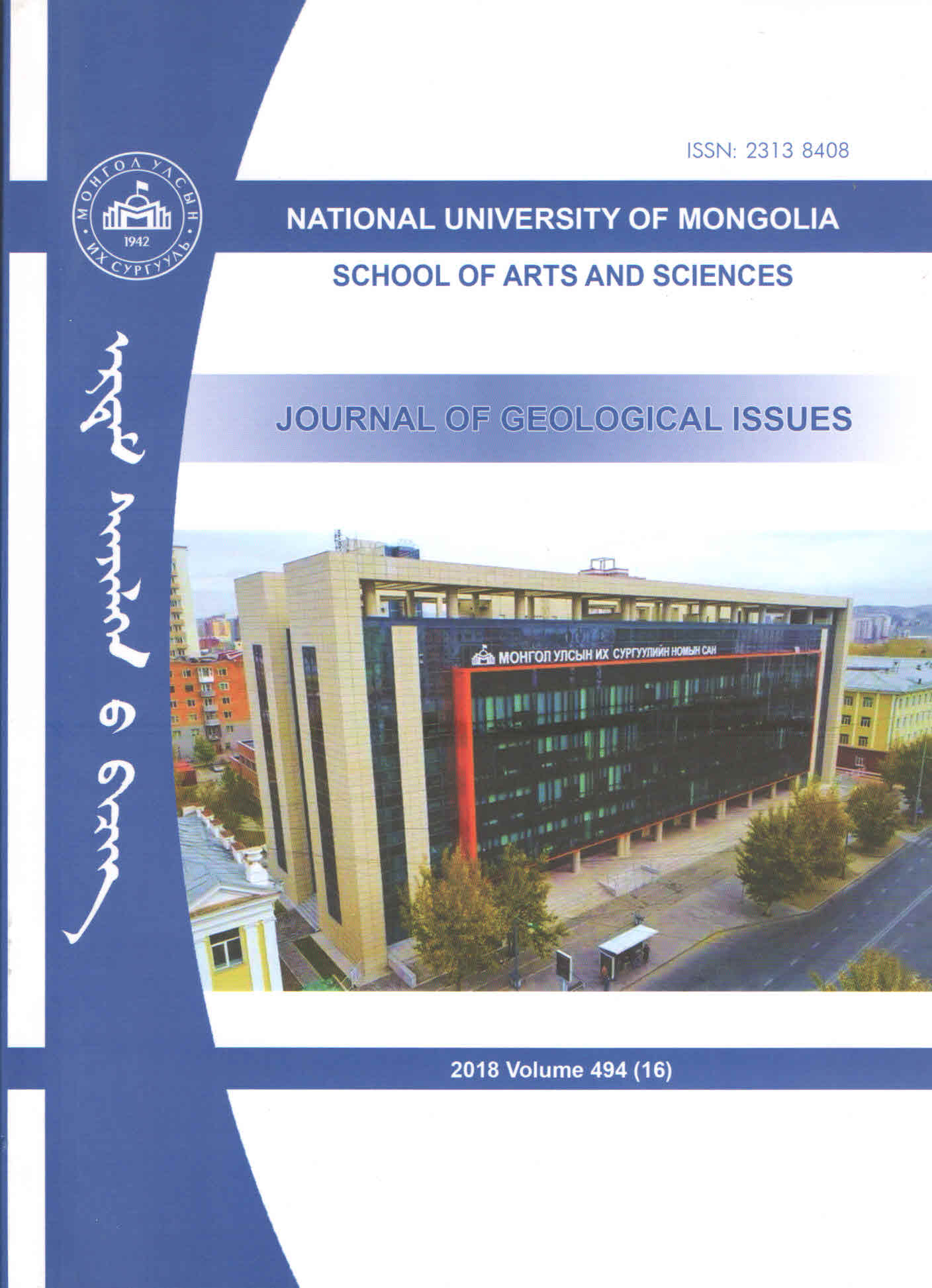Preliminary results of the solid-state C-13 NMR study of Mongolian coals: Implications for oil and gas potential and liquefaction reactivity
Keywords:
coal, petroleum potential, NMR, MongoliaAbstract
Chemical structures of five coals from Mongolia were studied using solid-state C-13 NMR and oil and gas potential as well as yields of liquefaction products of the coals have been predicted. Pennsylvanian ZG, Upper Permian TT and Lower-Middle Jurassic AT-5 coals might have more potential for gas due to abundant aliphatic and aromatic CH3 carbons. Lower-Middle Jurassic KH coal probably has more potential for oil because of its increased CH2 content. Lower Cretaceous SO-3 coal may have more potential for gas, but significant amount of non-hydrocarbon gases could also be generated simultaneously. The prediction of yields of liquefaction product shows that ZG, TT and AT-5 and KH coals could yield similar hydrocarbon gas, oil and residue. Cretaceous SO-3 coal is predicted to give the lowest yields of oil, hydrocarbon gas and residue compared with others. KH sample has the highest oil yield due to its high content of CH2.
Keywords: coal, petroleum potential, NMR, Mongolia
Downloads
References
Almendros, G., Knicker, H., Gonzalez-Vila, F.J., 2003. Rearrangement of carbon and nitrogen forms in peat after progressive thermal oxidation as determined by solid-state 13C- and 15N-NMR spectroscopy. Organic geochemistry 34, 1559-1568.
Boudou, J., P., Espitalie, J., Bimer, J., Salbut, P.D., 1994. Oxygen groups and oil suppression during coal pyrolysis. Energy & Fuels 8, 972-977.
Chen, J., Liang, D., Wang, X., Zhong, N., Song, F., Deng, Ch., Shi, X., Jin, T., Xiang, Sh., 2003. Mixed oils derived from multiple source rocks in the Cainan oilfield, Junggar basin, Northwest China. Part I: Genetic potential of source rocks, features of biomarkers and oil source typical cruide oils. Org. Geo., 34, 889-909.
Cramer, B., 2004. Methane generation from coal during open system pyrolysis investigated by isotope specific, Gaussian distributed reaction kinetics. Organic Geochemistry 35, 379-392.
Diessel, C.F.K., 1992. Coal-bearing Depositional Systems. Springer-Verlag, Berlin, p.41-74.
Difan, H., Dajiang, Z., Jinchao, Li., Xiaoming, H., 1991. Hydrocarbon genesis of Jurassic coal measures in the Turpan basin, China. Organic Geochemistry 17, 817-837.
Erdenetsogt, B., Lee, I., Bat-Erdene. D, Jargal, L., 2009. Mongolian coal-bearing basins: Geological settings, coal characteristics, distribution, and resources. Int. Jour. of Coal Geology 80, 87-104.
Erdenetsogt, B., Lee, I., Lee, S.K., Ko, Y.J., Bat-Erdene, D., 2010. Solid-state C-13 CP/MAS NMR study of Baganuur coal, Mongolia: Oxygen-loss during coalification from lignite to subbituminous rank. International Journal of Coal Geology 82, 37-44.
Hatcher, P.G., 1988. Dipolar-dephasing 13C NMR studies of decomposed wood and coalified xylem tissue: Evidence for chemical structural changes associated with defunctionalization of lignin structural units during coalification. Energy and Fuels 2, 48-58.
Hatcher, P.G., Clifford, D.J., 1997. The organic geochemistry of coal: from plant materials to coal. Organic geochemistry 27, 251-274.
Johnson, C.L., Greene, T.J., Zinniker, D.A., Moldowan, J.M., Hendrix, M.S., Carroll, A.R., 2003. Geochemical characteristics and correlation of oil and nonmarine source rocks from Mongolia. AAPG Bulletin 87, 817–846.
Longbottom, T., L., Hockaday, W., C., Boling, K.,C., Li, G., Letourmy, Y., Dong, H., Dworkin, S.I., 2016. Organic structural properties of kerogen as predictors of source rock type and hydrocarbon potential. Fuel 184, 792-798.
Mao, J.D., Hu, W.G., Schmidt-Rohr, K., Davies, G., Ghabbour, E.A., Xing, B., 2000. Quantitative characterization of humic substances by solid-state carbon-13 nuclear magnetic resonance. Soil Sci. Soc. Am. J. 64, 873–884.
Obeng, M., Stock, L.M., 1996. Distribution of pendant Alkyl groups in Argonne premium coals. Energy & Fuels 10, 988-995.
Pashin, J. C., 2008, Coal as a petroleum source rock and reservoir rock, in Ruiz, I. S., and Crelling, J. C. (eds.), Applied Coal Petrology—The Role of Petrology in Coal Utilization: Amsterdam, Elsevier, p. 227-262.
Pentilla, W.C., 1994. The recoverable oil and gas resources of Mongolia. Journal of Petroleum Geology 17, 89-98.
Petersen, H., I., Nytoft, H., P., 2006. Oil generation capacity of coals as a function of coal age and aliphatic structure. Org. Geochem. 37, 558-583.
Petersen, H.I., Rosenberg, P., Nytoft, H.P., 2008. Oxygen groups in coal and alginate rich kerogen revisited. International Journal of Coal Geology 74, 93–113.
Qin, K., Deyu, Chen, D., Li, Zh., 1991. A new method to estimate oil and gas potentials of coals and kerogens by solid state 13C NMR spectroscopy. Org. Geochem. 17, 865-872.
Saxby, J.D., 1980. Atomic H/C ratios and generation of oil from coals and kerogens. Fuel 59, 305-307.
Vandenbroucke, M., Largeau, C., 2007. Kerogen origin, evolution and structure. Org.Geochem. 38, 719-833.
Wilkins, R., W., T., George, S.C., 2002. Coal as a source rock for oil: Review. International Journal of coal geology 50, 317-361.
Xiao, Q., He, S., Yang, Z., He, Z., Furing, W., Li, S., Tang, D., 2010. Petroleum secondary migration and accumulation in the central Junggar basin, northwest China: Insights from basin modeling. AAPG bulletin 94, 937-955.
Yamamoto, M., Bat-Erdene, D., Ulziihutag, P., Watanabe, Y., Imai, N., Kajiwara, Y., Takeda, N., Nakajima, T., 1998. Organic geochemistry and palynology of Lower cretaceous Zuunbayan oil shales, Mongolia. Geological Survey of Japan Bulletin 49, 257-274.
Yoshida, T., Sasaki, M., Ikeda, K., Mochizuki, M., Nogami, Y., Inokuchi, K., 2002. Prediction of coal liquefaction reactivity by solid-state 13C NMR spectral data. Fuel 81, 1533-1539.
Downloads
Published
How to Cite
Issue
Section
License
Copyright (c) 2023 Геологийн асуудлууд

This work is licensed under a Creative Commons Attribution-NonCommercial-ShareAlike 4.0 International License.


